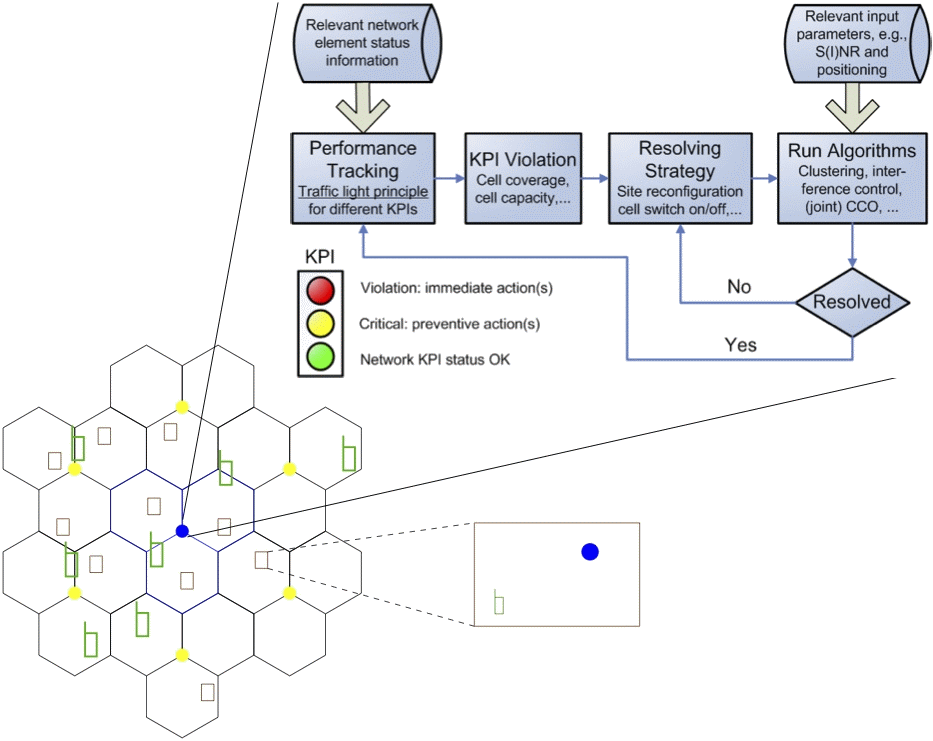Self-Organizing Networks (SON)

Concerning operation of modern radio networks, self-organization is a key concept to adapt radio parameters of the network equipment autonomously, i.e., without human intervention and without the corresponding personnel expenses. Application of SON functionalities generally aims at minimization of resource consuming task in terms of computational complexity, time consumption, communication overhead, and man power. These networks are both flexible and versatile as they are capable of dynamically adapting to network conditions and autonomously optimizing their performance with respect to some desirable parameters such as sum throughput, minimum throughput or energy efficiency. This concept is recently being supported by developments in cloud networks which allow for better resource management, cooperation and synchronization through their centralized infrastructure. The integration of the aforementioned concepts is especially challenging and interesting for multi-tier heterogeneous networks.
The development of models and algorithms for self-organized radio network operation covers various aspects, e.g.,- modeling (heterogeneous) cellular networks,
- user traffic patterns,
- interference modeling and management in multi-tier networks, e.g., interference mitigation, avoidance and coordination,
- joint performance optimization, e.g., sum throughput, max/min data rate, energy efficiency, outage probability,
- dynamic cell association and expansion schemes, e.g., resource aware, distance aware, rate dependent and
- development of protocols and control strategies to facilitate cognitive functions.
Related research topics and publications
-
Self-Organization for 4G Multi-Tier Networks
(January 2011 - April 2012)
Joint research and development project with Huawei Technologies, Dusseldorf / Shenzhen (China).
Performance optimization via association, power and antenna management
- O. Taghizadeh, R. Mathar, Interference Mitigation via Power Optimization Schemes for Full-Duplex Networking, Proceedings: 19th International ITG Workshop on Smart Antennas (WSA 2015), Ilmenau, Germany, March 2015.
- X. Xu, G. Kutrolli, R. Mathar, Dynamic Downlink Power Control Strategies for LTE Femtocells, Proceedings: 7th International Conference on Next Generation Mobile Applications, Services, and Technologies (NGMAST), Prague, Czech, September 2013.
- X. Xu, G. Kutrolli, R. Mathar, Energy Efficient Power Management for 4G Heterogeneous Cellular Networks, Proceedings: IEEE 9th International Conference on Wireless and Mobile Computing, Networking and Communications (WiMob), Lyon, France, October 2013.
- S. Corroy, L. Falconetti, R. Mathar, Cell Association in Small Heterogeneous Networks: Downlink Sum Rate and Min Rate Maximization, Proceedings: IEEE Wireless Communications and Networking Conference (WCNC 2012), Paris, France, March 2012.
- A. Engels, M. Reyer, X. Xu, R. Mathar, J. Zhang, H. Zhuang, Autonomous Self-Optimization of Coverage and Capacity in LTE Cellular Networks, Vehicular Technology, IEEE Transactions on, vol. 62, no. 5, pp. 1989-2004, June 2013.
- M. A. Ismail, X. Xu, R. Mathar, Autonomous antenna tilt and power configuration based on CQI for LTE cellular networks, Proceedings: The Tenth International Symposium on Wireless Communication Systems 2013 (ISWCS), Ilmenau, Germany, August 2013.
Related student work
- Diploma Thesis Selbst-Optimierung der Abdeckung und Kapazität für LTE Netze
- Student research project Autonome Leistungskontrolle in mehrstufigen Netzen
- Student research project Selbst-Organisierung in OFDM-basierten heterogenen drahtlosen Netzwerken
Contact
For further information contact:
***
Aktuelle Informationen gemäß Art. 13 DS-GVO:
Datenschutzhinweis ***
Impressum ***

